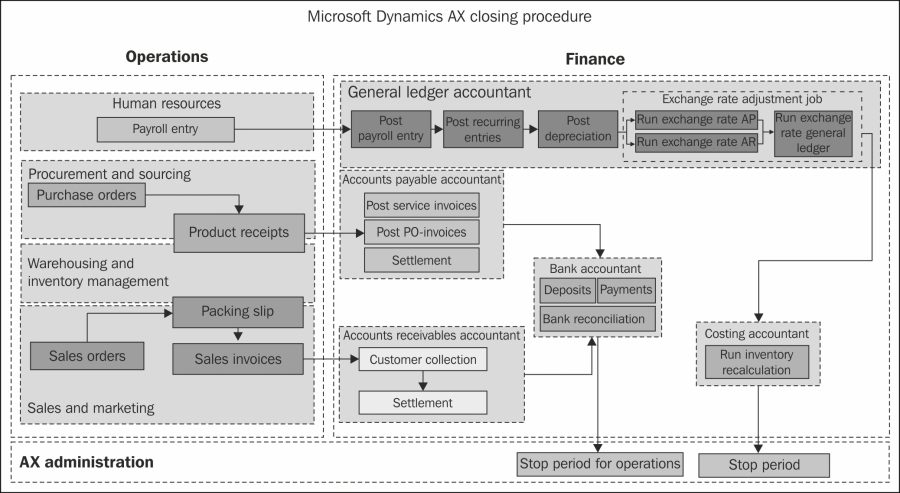The closing procedure is a common practice at organizations to finalize the monthly transactions and report the monthly financial reporting. The procedure varies from one company to another, but it has common steps between company departments.
The finance controllership department is responsible for the closing procedure, where accountants follow up with the operations department to confirm that they have posted the monthly transactions in the ERP. The following figure explains the closing procedure in detail:

All the departments in a company are involved in the monthly closing process. The Human resources department calculates the payroll and generates the payroll entry to be validated and posted by the general ledger's accountant.
The Procurement department ensures that they have confirmed all purchase orders to be received at the warehouse and the warehouse keeper confirms receiving them as it affects the inventory quantities and values. On the other side, the accounts payable accountants match and post purchase order invoices as well as service invoices. They then execute payments of due invoices that are related to the closing month.
The Sales department verifies that they have confirmed all sales orders to be delivered to the customer and issue sales invoices accordingly, which generates the revenue and cost of goods sold. In the Finance department, the accounts receivable accountant posts the customers' collections and settlements.
During this time, the fiscal period is stopped for all operations to prevent any further operational entries in that month and only the financial team is allowed to post the financial adjustment entries.
The general ledger's accountant posts the recurring entries such as rental and accruals. So, first run the fixed assets depreciation and exchange rate adjustment for subledgers (accounts payable and accounts receivable) and then run the exchange rate adjustments for the general ledger.
The costing accountant runs the inventory recalculation to adjust the average cost of inventory items and adjusts the sold quantities by the proper cost. They stop the fiscal period after finalizing the inventory calculation.
The management of financial periods is an administrative task. There are three stages for the period status.
To access the Period status window, navigate to General ledger | Setup | Ledger, then click on the Ledger calendar button, and go to the Periods fast tab, as shown in the following screenshot:

All transactions that are executed have the Open status in the Period status drop-down list.
After ensuring that all departments have entered and posted their transactions (relevant to the current month) as well as the financial post (the month-end adjustment transactions), the financial period status drop-down list is set to Open for a specific user group and modules.
In order to access the modules' access level path, navigate to General ledger | Setup | Ledger, then click on the Ledger calendar button, and go to the Modules access level fast tab.

After dealing with the details of the financial department, make all the required adjustments for the current month. The financial Period status drop-down list is set to On Hold (formerly known as Stopped in Microsoft Dynamics AX 2009), which prevents any entry being posted in that period; but it can be reopened after that.
There is another possible scenario: changing Period status to Closed. However, this status cannot be reopened again.
